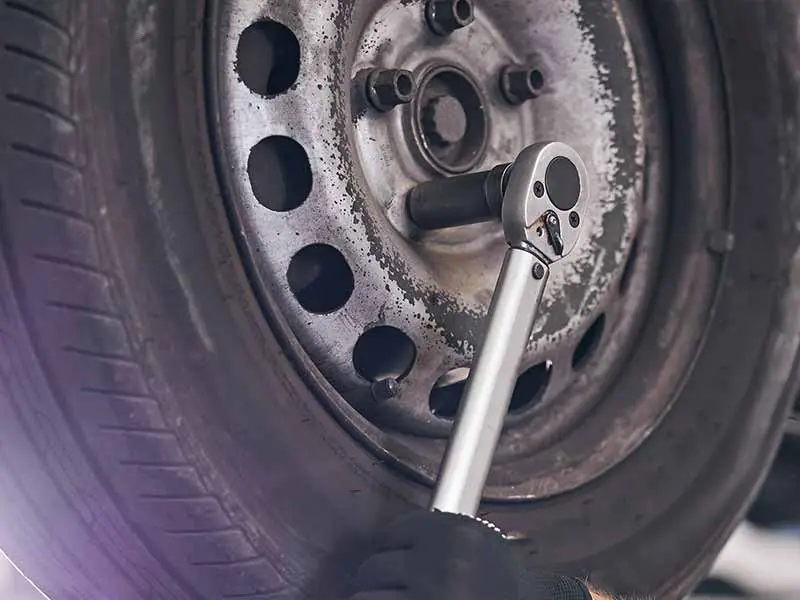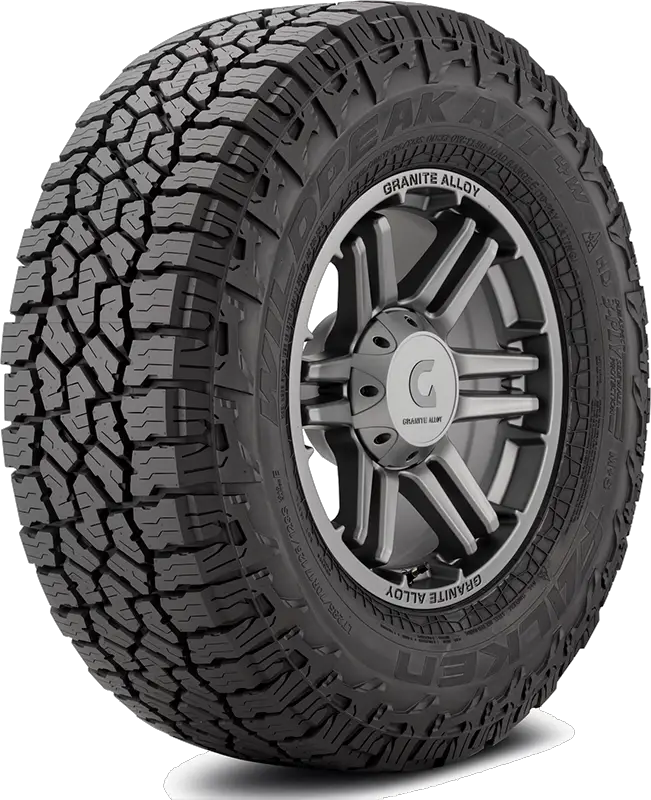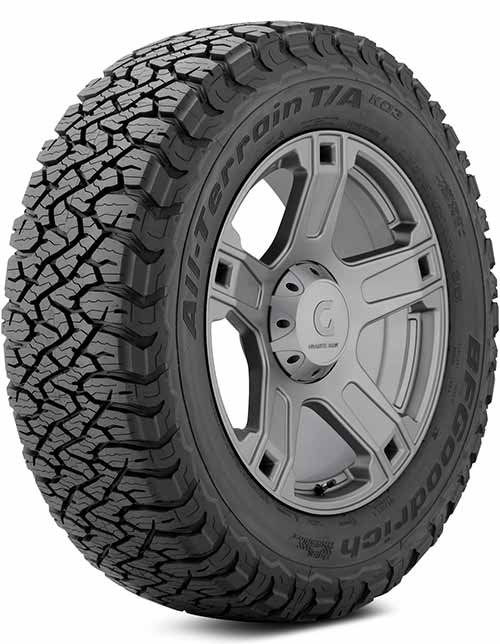We’ve all felt an unexpected wobble in the steering wheel or heard that mysterious ticking sound from our car and thought, “Is that normal?” What if that tiny sound or tremor could be hinting at a much larger, imminent issue with your vehicle’s wheels and lug nuts?
Symptoms Of Loose Lug Nuts
Common symptoms of a loose lug nut are noises, especially a rattling or clicking sound, and vibrations that can be felt primarily through the steering wheel.
If left unchecked, these symptoms can lead to severe damage or even the loss of a wheel while driving.
In this article, we’ll dive deep into the world of lug nuts, decoding the signs of them being loose, understanding their critical role in vehicle safety, and learning the best practices to ensure you’re always cruising safely on the road.
Let’s take a closer look.

Common Symptoms of Loose Wheel Nuts
Let’s describe the specific signs you need to keep an eye out for:
Noise from a Wheel
Hey, ever heard that weird, unexplained rattling or clicking noise while driving? It might not be some random car ghost, but something more tangible: loose lug nuts.
Types of Noises You Might Hear:
- Clicking Sounds: Like a soft metronome, these clicking noises tend to speed up as you drive faster.
- Rattling Sounds: These are less rhythmic than clicking but can be a clear sign that something’s off with your lug nuts.
So, if you hear any of these noises, it’s a good hint to check things out before your road trip turns into a roadside fiasco.
Vibration and Steering Issues
Driving should be smooth sailing. But if you feel unusual steering feedback or vibrations while driving, it might be a sign your lug nuts need some attention.
What’s Happening with the Wheel Vibration?
- Uneven Force: When lug nuts aren’t tightened properly, the clamping force on the wheel gets all out of whack. This can lead to uneven rotations and, you guessed it, those not-so-fun vibrations.
- Feedback in the Steering Wheel: This is where you’ll likely feel it first. If the front wheels are the culprits, your steering wheel might shake or vibrate, especially at certain speeds.
The Wheel Bearings Connection
Wheel bearings are like the silent supporters of your wheels. They let your wheels spin smoothly. But if lug nuts are loose:
- Extra Strain: The wheel wobbling can put more strain on these bearings.
- Potential Damage: Over time, this can wear down or even damage the wheel bearings. And trust me, that’s a repair bill you’d rather avoid.

Lug Nut Example
Lug Nut Basics
It’s pretty obvious that your lug nuts keep your vehicle’s wheels firmly attached to its hub. They may look simple, but this is obviously super important job. When you think about it, they’re holding the weight of your entire vehicle!
Here’s a quick rundown of some terms you’ll come across:
- Wheel Lugs: These are essentially the nuts. They’re the parts you twist on and off when changing a tire.
- Lug Bolts: Think of these as the opposite of wheel lugs. Instead of nuts on the end of a stud, the wheel is attached with bolts that screw into the hub.
- Wheel Studs: These are like the anchor bolts for your wheels. They stick out from the hub, and the lug nuts are twisted onto them.
Clamping Force
- What It Is: Clamping force is like a powerful hug for your wheels. It’s the force that keeps the wheel snugged up against the car. When everything is tightened properly, this force ensures your wheel isn’t going anywhere without the rest of the vehicle.
- Why It Matters: Without the right clamping force, you could damage the wheel studs, warp brake rotors, or your wheels could start to wobble. That wobble might lead to more serious problems.
Securing the Wheel to the Vehicle
When you tighten lug nuts in the right sequence and to the right torque setting, they distribute an even force around the wheel. This keeps things balanced and, more importantly, secure.
Here’s a brief step-by-step of how this works:
- The wheel studs pass through holes in the wheel.
- The lug nuts are then hand-tightened onto these studs.
- Using a torque wrench, they’re tightened to just the right amount, usually in a star pattern to better ensure all nuts get properly tightened. Not too loose, and not too tight by torquing to the manufacturer’s specification.
- This creates the necessary clamping force to keep the wheel safely in place without damaging the threads on the studs or warping brake rotors.

Risks of Driving with Loose Lug Nuts
Loose lug nuts aren’t just a minor inconvenience. They’re a safety hazard. And not just for you, but for everyone else on the road, too.
Worst Case Scenario
Imagine for a moment: You’re cruising on the highway, wind in your hair, when suddenly one of your wheels decides it’s tired of being attached. It bolts (pun intended) and takes off on its own adventure. Scary, right?
- Loss of Control: A missing wheel doesn’t just mean a bumpy ride; it means your vehicle could go out of control.
- Accidents: We don’t have to spell out what might happen next. Cars, pedestrians, property – it’s all at risk.
It’s Not Just About the Wheel
Loose lug nuts don’t just threaten the wheel’s attachment. They can harm other parts of your car.
- Braking System: With an unstable wheel, your brakes might not function properly. In a tight spot, that’s a real problem.
- Suspension: That ongoing wobble? It’s not doing your car’s suspension any favors.
Impact on Wheel Bearings and Other Components
We’ve touched on this a bit, but let’s dive deeper.
Wheel Bearings: The Unsung Heroes
These little guys allow your wheels to rotate smoothly and freely. But when lug nuts are loose:
- Premature Wear: The wobble from loose lug nuts can cause these bearings to wear out faster than usual.
- Potential Breakdown: In extreme cases, wheel bearings might even break or fail. When that happens, the wheel doesn’t spin so freely anymore.
More Than Just Bearings
Loose lug nuts don’t play favorites when it comes to damaging your car. Other parts can suffer too.
- Wheel Hub: The hub, which holds the wheel in place, can get damaged from the constant wobbling.
- Brake Rotor: Your brake rotors can become warped, leading to inefficient braking.

Wheel Bolt Example
Troubleshooting Loose Lug Nut Issues
When Lug Nuts Are Tight but Wheel Is Loose
Here’s a puzzler: You’ve checked the lug nuts, and they seem tight. Yet, the wheel still wobbles like a toddler’s first steps. What’s up with that?
The Mystery Unveiled
- Worn Wheel Studs: Sometimes, the studs themselves are worn down. They might seem tight when you check, but they’re not holding the wheel securely.
- Damaged Hub Surface: If the surface where the wheel meets the hub is damaged or corroded, it can create an unstable fit, even if the lug nuts are tight.
- Cross-threaded Nuts: This is when the lug nut is screwed on at an angle instead of straight. It may feel tight, but it’s not properly seated.
- Incorrect Depth Wheel Bolts Or Lug Nuts: If you’re not using the wheel bolts or lug nuts that came with your car or truck, they may not be able to properly clamp the wheel to the hub even when torqued to the proper specs.
How Long Before Loose Lug Nuts Become a Major Problem?
Nobody wants to play “Wheel Roulette.” So, how long do you have before those loose lug nuts become a catastrophe?
The Unpredictable Timeline
- Varies by Vehicle: It’s hard to give a one-size-fits-all answer. Larger, heavier vehicles might see problems sooner than smaller, lighter ones.
- Driving Conditions Matter: If you’re mostly cruising smooth highways, you might have more time than if you’re off-roading or hitting potholes daily.
- Safety First: While it’s interesting to wonder about, the real answer is: if you know or suspect your lug nuts are loose, deal with it ASAP. It’s not worth the risk.
Checking Your Wheel Nuts
Ensuring your lug nuts are tight and right is pretty straightforward. Here’s a mini-guide to get you started.
The Right Tools for the Job
- Torque Wrench: This isn’t just a fancy wrench. It lets you tighten the lug nuts to the exact tightness they need. Remember, it’s not about muscle; it’s about precision.
- Vehicle Manual: Yep, that book in your glove compartment you’ve never opened. It’ll tell you the correct torque setting for your lug nuts.
Step-by-Step Check
- Park Safely: Find a level surface and engage your parking brake.
- Loosen & Retighten: If you don’t have a torque wrench, just ensure each lug nut is snug. But don’t go full Hulk on them. Over-tightening can be as bad as under-tightening.
- Use That Torque Wrench: If you’ve got one, set it to the recommended torque setting from your manual. Tighten each lug nut in a criss-cross pattern. This ensures an even fit.
- Double-Check: Once all are tightened, go around once more to make sure they’re all set.
Resources
Below are some links you may find helpful when learning about tires
- See what happens if you drive with loose wheel bolts – Motor1
- Indicators of loose wheel nuts – It Still Runs
Final Thoughts
The little components on our cars, like lug nuts, can have a massive impact on our driving safety and vehicle performance. As we’ve discovered, the symptoms of loose wheel nuts – such as unusual noises and vibrations – aren’t just small annoyances but warning signals of potential danger ahead.
Regular maintenance, using the right tools like a torque wrench, and being attentive to any changes in your vehicle’s behavior are crucial. Remember, it’s always better to catch these issues early, ensuring that every journey you take is as smooth and safe as possible.
Good luck and happy motoring.




